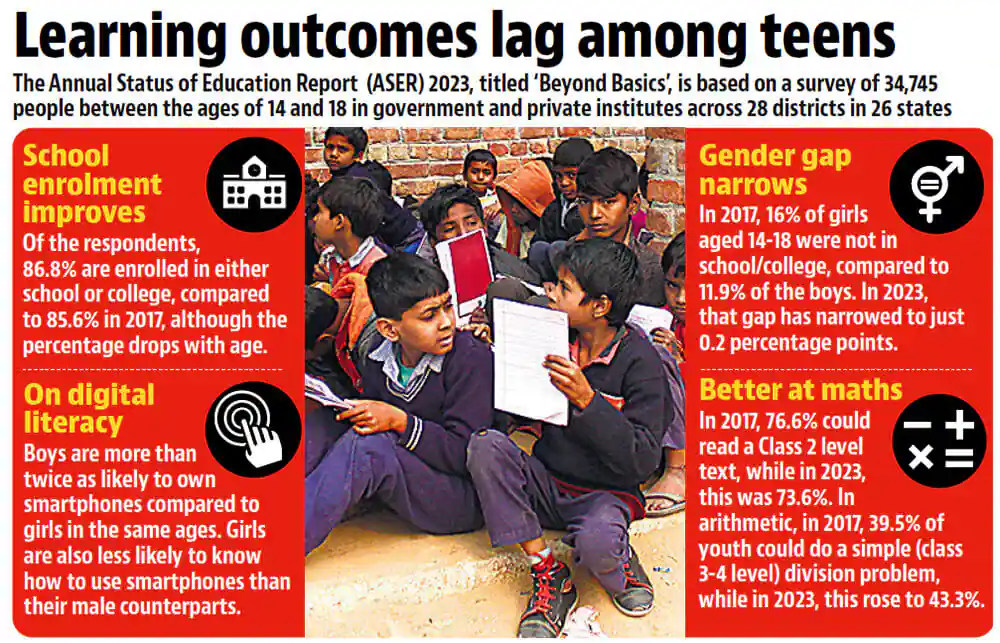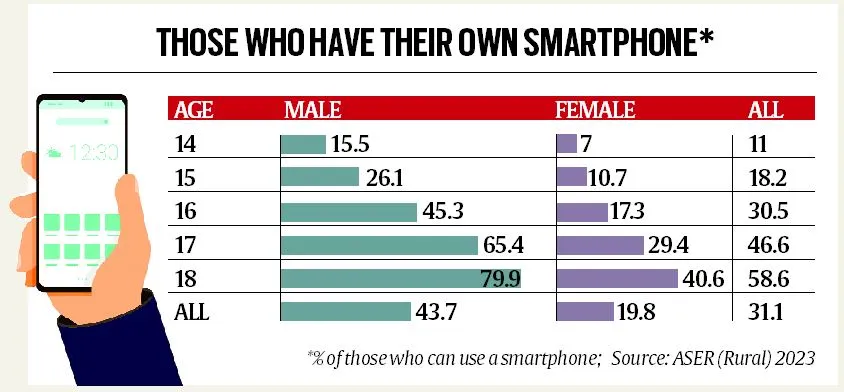Social Justice
ASER 2023: Examining Education Beyond Basics
- 20 Jan 2024
- 15 min read
This editorial is based on “ASER 2023 report: On education, let’s listen to the teenagers” which was published in Indian Express on 19/01/2024. The article discusses the recently published ASER 2023: Beyond Basics report, which brings attention to multiple concerns and provides recommendations aimed at enhancing fundamental learning outcomes within the Indian education system.
For Prelims: ASER 2023, NEP 2020, Social Media, PISA (Programme for International Student Assessment), Demographic dividend, STEM stream
For Mains: About Annual Status of Education Report, Key Findings of the Report, Key Concerns Highlighted in the Report.
In the last 20 years, discussions revolving around schooling and basic learning in education have led to significant changes in policies and priorities in India. Recently, the ASER 2023: Beyond Basics report was conducted in 28 districts across 26 states, involving 34,745 youth aged 14-18. Focusing on adolescents, the report provides new ideas on how to improve learning outcomes for young people in India and make the most of the country's demographic dividend.
What is the Annual Status of Education Report (ASER 2023: Beyond Basics)?
- About:
- ASER is a nationwide citizen-led household survey facilitated by NGO Pratham Education Foundation that provides a snapshot of the status of children’s schooling and learning in rural India.
- The ‘basic’ ASER collects information about enrollment in preschool and school for children in the age group of 3 to 16 and assesses children aged 5 to 16 one-on-one to understand their foundational reading and arithmetic abilities.
- First implemented in 2005, the 'basic’ ASER survey was conducted annually until 2014 and switched to an alternate-year cycle in 2016.
- Objectives:
- The 2023 survey focused on 14-to-18-year-old children in rural India, specifically on their ability to apply reading and math skills to everyday situations, and their aspirations.
- The recent survey set out with the overarching objective of generating evidence on diverse aspects of youth development in rural India, that stakeholders across sectors could use to inform policy and practice.
- The 2023 survey explored the following domains:
- Activity: What activities are India’s youth currently engaged in?
- Ability: Do they have basic and applied reading and math abilities?
- Digital awareness and skills: Do they have access to smartphones? What do they use smartphones for, and can they do simple tasks on their smartphones?
- Aspirations: What do they aspire to become? Who are their role models?
What are the Key Findings of the Report?
- Activity:
- Increased Enrollment: Overall, 86.8% of 14-18-year-olds are enrolled in an educational institution. The percentage of youth not enrolled is 3.9% for 14-year-old youth and is 32.6% for 18-year-olds.
- Vocational Training: Youth at the college level are the most likely to be taking vocational training (16.2%). Most youths are taking short-duration courses (of 6 months or less).
- Ability:
- Foundational Skills: About 25% of this age group (14-18) still cannot read a Std II level text fluently in their regional language.
- More than half struggle with division (3-digit by 1-digit) problems. Only 43.3% of 14-18-year-olds are able to do such problems correctly.
- Everyday Calculations: Nearly 85% of surveyed youth can measure length using a scale when the starting point is 0 cm.
- This proportion drops sharply to 39% when the starting point is moved. Overall, close to 50% of youth can do other common calculations.
- Daily Life Applications: Among youth who can read a Std I level text or more, about two-thirds can answer at least 3 out of 4 questions based on reading and understanding written instructions.
- Financial Calculations: Of the youth who can do subtraction or more, over 60% are able to do the budget management task, about 37% can apply a discount, but only about 10% can calculate repayment.
- However, females perform worse than males on almost all tasks.
- Foundational Skills: About 25% of this age group (14-18) still cannot read a Std II level text fluently in their regional language.
- Digital Awareness and Skills:
- Digital Access: Close to 90% of all youth have a smartphone in the household and know how to use it.
- Females are less likely to know how to use a smartphone or computer as compared to males.
- Communication and Online Safety: Of all youth who used social media, only about half are familiar with the online safety settings that were included in the survey.
- Digital Tasks: 70% of youth can browse the internet to find the answer to a question and about two-thirds can set an alarm for a specific time.
- A little over a third can use Google Maps to find the time taken to travel between two points. Across all tasks, males outperform females.
- Digital Access: Close to 90% of all youth have a smartphone in the household and know how to use it.
What are the Key Concerns Highlighted in the Report?
Challenges Posed by Limited Academic Success:
- Low levels of Foundational Numeracy: The report highlights inadequate levels of foundational numeracy which may significantly hinder the ability of young individuals to handle day-to-day calculations.
- Flat Learning Trajectories: Over the time, there hasn't been significant improvement in the academic progress of students.
Challenges Posed by Curriculum Constraints:
- Acute Academic Competition: Parents in India often harbor overambitious aspirations for their children. These aspirations of parents translate into acute academic competition, widespread coaching, and heavy expenditure by families.
- All of these add to examination pressures often accompanied by severe disappointments for the student and the family if exam results are poor.
- Overambitious Curriculum: The Indian education system has an “over-ambitious” curriculum which does not take into account that many students have large learning deficits and are unable to cope with the grade level curriculum.
- For instance, in 2009, the only year when two states in India participated in PISA (Programme for International Student Assessment), the results were second last, just above Kyrgyzstan.
Challenges Posed by Ambiguous Aspirations:
- Not Motivated to Study: In the survey findings, a larger proportion of boys than girls reported not wanting to study after class 12. During the discussion, girls discussed wanting to study at least to undergraduate level, while boys talked about earning money.
- Not surprisingly, the proportion of youth who are currently not enrolled in school or college rises with age from 3.9% of 14-year-olds to 10.9% of 16-year-olds and 32.6% of 18-year-olds.
- The Dearth of Clarity: There is a lack of clear guidance for students when it comes to making decisions about their future. Many students are unsure about what to study, how much more education they need, and what kinds of jobs they should be aiming for.
- One out of every five youths were unable to name any type of work or job that they aspired to,” mentions the ASER report.
- No Role Model: From the figures shared in the ASER report, of the students surveyed, 42.5% of males and 48.3% of females did not have a role model for their aspired work.
Challenges posed by Digital Deprivation:
- Less Technical inclination: Most of the young people in this age group were enrolled in the Arts/Humanities stream. In Std XI or higher, more than half are enrolled in the Arts/Humanities stream (55.7%), followed by STEM (31.7%) and Commerce (9.4%).
- Females are less likely to be enrolled in the STEM stream (28.1%) than males (36.3%).
- Surface Layer Use of Digital Component: Close to 80% of the youth report having used their smartphone to do an entertainment-related activity, such as watching a movie or listening to music, during the reference week.
- The digital component is interesting because, at one level, it shows that everybody knows how to use the basic things. But they’re not using it in depth; they’re using the surface layer, say, mainly engaging with social media
- Gender gap in Tech Access: Males are more than twice as likely to own their own smartphone than females, and therefore were likely spending far more time using the device and using it for a wider variety of tasks.
What Should be the Way Forward ?
Ease Out Early Childhood Struggles :
- Financial Aid and Grants: Provide financial aid and grants to economically disadvantaged students as many of these students need to earn and support their families financially during this age group and it's a vicious cycle.
- Shifting the Social Norms: Among girls, shifting social norms with regard to the appropriate age of marriage emerged as a key driver of young women's ability to study further.
Comprehensive Strategy for Learning Improvement :
- Flexible Education System :Embracing flexibility often involves leveraging technology to facilitate remote learning, online resources, and interactive platforms, enhancing the overall educational experience. There should be a way for a student to register for multiple kinds of learning and earning opportunities.
- Reform Assessments : NEP 2020 speaks of the goal of 100% secondary school enrolment, to be achieved through “careful tracking of students’ enrolment, attendance, and learning levels, so that they can be provided suitable opportunities to re-enter school or catch up”.
- Examination pressure can be reduced by reforming how and when assessments can happen.
- Pathway Linking: Linking secondary school reform concepts with NIPUN will be crucial in transforming school reform ideas into practical measures.
- A close tracking of outcomes will be key to improvements and eventual success.
Prepare Future Ready Students :
- Focus on Developing Critical Thinking: Curriculum content will be reduced in each subject to its core essentials, to make space for critical thinking and more holistic, inquiry-based, discovery-based, discussion-based, and analysis-based learning.
- Future Oriented School Systems: Our school education system is needs to be modified to drive students more future-oriented who can help and guide the kids into paths that may benefit them and place them in secure position
- Digital Mentorship Programs: Implement digital mentorship programs connecting students with professionals and experts in their fields of interest. This can help guide students in making informed decisions about their future.
Conclusion
As an emerging economy , it is crucial to sufficiently empower the youth with necessary knowledge, skills, and opportunities, enabling them to steer their own advancement as well as that of their families and communities. The true potential of India's expected "demographic dividend" and "digital dividend" can be realized through these comprehensive actions.
|
Drishti Mains Question: Discuss the primary challenges in enhancing learning outcomes for young individuals in India. What measures can be recommended to address these issues effectively? |
UPSC Civil Services Examination, Previous Year Question:
Prelims:
Q. Consider the following statements: (2018)
- As per the Right to Education (RTE) Act, to be eligible for appointment as a teacher in a State, a person would be required to possess the minimum qualification laid down by the concerned State Council of Teacher Education.
- As per the RTE Act, for teaching primary classes, a candidate is required to pass a Teacher Eligibility Test conducted in accordance with the National Council of Teacher Education guidelines.
- In India, more than 90% of teacher education institutions are directly under the State Governments.
Which of the statements given above is/are correct?
(a) 1 and 2
(b) 2 only
(c) 1 and 3
(d) 3 only
Ans: B
Mains:
Q. How have digital initiatives in India contributed to the functioning of the education system in the country? Elaborate your answer. (2020)








